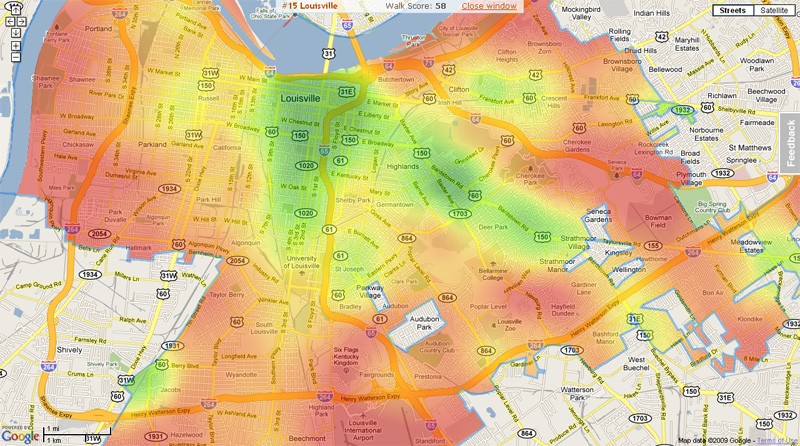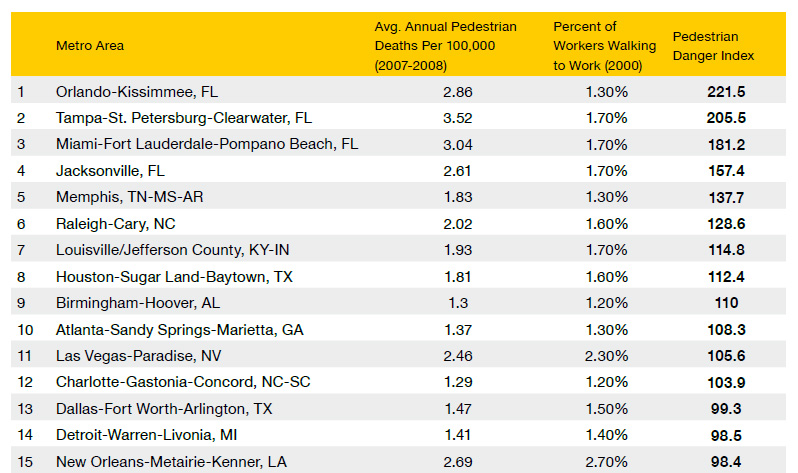The big news so far this week is that if you walk in the Louisville Metro area, you’re taking your life into your own hands. A new report called Dangerous by Design co-authored by Transportation for America and Tri-State Transportation Campaign analyst Michelle Ernst reveals that Louisville is the 7th most dangerous metropolitan area over one million people for pedestrians. That’s right, it’s more dangerous to be a pedestrian in Louisville than in notoriously bad pedestrian environments such as Houston or Las Vegas.

To level the playing field among cities with varying pedestrian counts, the rankings were determined using a Pedestrian Danger Index representing the ratio between the average pedestrian fatality rate per 100,000 residents in a two-year period and the percentage of residents who commute to work by foot. Results represent the entire urban region rather than just the core city.
Louisville’s poor ranking is the result of many factors identified in the report including a trend for more low-density, auto-centric land use in the southern U.S. (Nine of the top ten worst cities are in the South, including the four worst in Florida). The report also notes that wide, fast-moving arterial roads that facilitate such sprawling development are to blame for 56 percent of pedestrian deaths nationwide. These streets (think Shelbyville Road or Dixie Highway) often lack safe pedestrian infrastructure including sidewalks and crosswalks.
Total pedestrian fatalities in the Louisville area between 2007 and 2008 numbered 48 accounting for 14.2 percent of all traffic deaths. Only 1.7 percent of residents in Louisville walked to work. The Cincinnati area, for example, saw 33 pedestrian deaths in the same period accounting for 8.5 percent of traffic fatalities. Cincinnati counted 2.3 percent of residents walking to work. The winners in Kentucky are Elizabethtown with zero pedestrian deaths and 2.9 percent of workers walking and Lexington with the highest rate of walkers at 3.5 percent.
Suggested improvements include investing in better street infrastructure or “complete streets” that make the public realm more inviting to pedestrians. This can be achieved by simply adding sidewalks and crosswalk, or implementing road diets or traffic calming techniques. Emphasis on walkable communities is also cited as a key solution indicating that land use patterns in our sprawling suburbs must be adapted to allow a mix of uses at an appropriate density for walking.
Pedestrian spending in Louisville doesn’t seem to be the problem, however. The Dangerous by Design report indicates that Louisville is also in the top ten metros (number 8) for “Highest Federal Spending on Pedestrian Safety per Person” with $2.39 spent on bike and pedestrian infrastructure per person. Providence, RI ranks highest with $4.01 per person.
If Louisville is spending among the most per person for pedestrian improvements but still ranks among the worst metro areas for safety, then we’re either not putting our money in the right places or there’s a more fundamental problem that must be addressed.
I’m not going to try and diagnose these problems right now, but I would be willing to guess that addressing speed will be a key factor. Dangerous by Design points out the alarming truth about a pedestrian’s survival rate when struck at various speeds. When hit at 20MPH, your chances of recovery are good at 95 percent. As speed increases, survival rate drops rapidly. At 30MPH, the rate stands at 55 percent and at 40MPH your chances of survival are only 15 percent. Considering so many of Louisville’s arterials have a posted speed limit of 45 (or sometimes more) miles per hour, it’s no wonder that so many pedestrian deaths occur on arterial roads.
There’s also some good news for local pedestrians: Louisville’s core city (the old city limits) has been identified as the 15th most walkable city in the country by WalkScore based upon availability of amenities (such as businesses or parks) within walking distance that allow for the possibility of a car-free lifestyle. You can see the walkability “heat map” below indicating in green the most walkable parts of Louisville.
Louisville is the highest ranked city in our region and the top five walkable neighborhoods include the Central Business District, Limerick, Phoenix Hill, Cherokee Triangle, and Old Louisville. In all, WalkScore estimates that 25 percent of residents live in an area designated “Very Walkable.”
So to wrap up, it appears that Louisville has some work ahead of it to make streets safer for pedestrians. We as a city will need to determine how best to use our funds as we are among the top cities in the country for pedestrian spending (and we have millions more in stimulus funding still ahead of us). The core of Louisville is already showing signs of walkability which should be strengthened while we also promote principles of walkable development throughout our city and region.
[ Editor’s note: We received word that the Dangerous by Design report was co-authored by Transportation for America and Tri-State Transportation Campaign Analyst Michelle Ernst, a change from what was originally reported. The article has been updated to reflect this. ]
- Dangerous by Design report (T4America)
- Transportation for America (Official Site)
- Surface Transportation Policy Partnership (Official Site)
- National Complete Streets Coalition (Official Site)
- Walk Score: Louisville (Official Site)



Excellent report and analysis, Branden. Thanks!
There are so many issues involved here: development, sidewalks, engineering, housing patterns, density, commuting… but one issue that doesn’t get discussed much (I’d tried to elicit a response in regard to cycling) is driving itself: skills, laws, patterns, habits, and attitudes.
When I first moved back to Louisville from Rochester NY, my first impression was that drivers here were a little more courteous, less aggressive, not relentlessly fast the way driving is in much of the Northeast… People will let you in, they don’t tailgate, and they don’t honk as as general rule.
But now I’m afraid I have to change my assessment a bit. About a year ago, out of frustration, I got a bumper sticker that says “Turn Signals: Use ’em People.” From other forums I’ve gotten the impression that many here think not using turn signals is charming and quirky and folksy or something. It’s not. It’s rude, lazy, selfish and dangerous. (I could point out it’s supposed to be illegal, but that’s almost irrelevant. I’m sure cops never ticket for it. Hell, THEY don’t use turn signals!) And it’s emblematic of what’s really wrong with Louisville drivers. They are not really present, not really aware of the road, not aware of much of anything. They are talking on the phone (illegal in NY), texting, watching tv, having dinner, whatever. I get the impression that many drive as though they’re sitting around their living room channel-surfing. Every once in a while they notice their living room is moving.
What using your turn signal habitually does for you as a driver is take you out of the living room. It makes you think ahead – about your next moves, your destinations, your need to be in another lane AHEAD OF TIME. I’m sure there are other habits of mind that need to be changed, but this one is a start.
I walk four miles every morning. I cross a number of streets and I have to walk carefully in a few places where there are no sidewalks. I try to be totally aware of what drivers are doing and anticipate their moves. I can’t tell you how many times I have found a car I assumed was going straight come barreling right at me. I have only one finger to defend myself.
How many feints, guesses, false starts, double takes, slammed brakes, jerked wheels happen because people don’t signal?
And how many deaths?
You would be amazed at how such a small thing as using turn signals can help out pedestrians. Besides being the law and a safe way to go for motorists, it lets walkers and cyclists know the intentions of the driver and provides a little heads up to plan your next move.
It's amazing dually how many people don't use turn signals for whatever reason and it's also a little strange how often I see people driving for miles with a turn signal left on.
To generalise a bit, Louisville drivers don’t like state changes. They light turns green – they like to sit still. The light turns red – they plow through anyway. They don’t like being challenged or having to change plans when the environment demands it.
Perhaps a change in the frequency people need to take driving exams to renew their license would help. I am sure there would be no political will to make something like this happen and the cost to conduct regular testing would surely be out of the question especially at this point in time. I can use my grandmother as a great example, I love her dearly but she should have been off the road a while ago. She lives on the east coast and I don’t get a chance to see her very often, but by the time I realized she was showing strong signs of dementia she had been driving like that for close to a year. Beyond the sadness of seeing a loved ones mental functions deteriorate, it is absolutely frightening that there is not some safety-net to identify high-risk drivers. She quit driving on her own because apparently the act of driving had become too confusing. And she has an excuse for poor driving, but there are many people who are fortunate enough to have clear cognitive abilities, yet choose not to utilize that power when behind the wheel. If people would follow simple rules of the road everyone would be much better off. Like people who decide to merge at the last minute in a construction site backing up traffic for miles when the problem would be completely eliminated by an orderly process.
Anyway, pedestrians and cyclists are not completely innocent either however. Riding a bike on the sidewalk as an adult in not legal as far as I know, and so many people do it. I should know because about 7 years ago I was riding on the extremely wide sidewalks along Baxter to avoid rush hour traffic when I was struck by a turning car whose driver didn’t make an effort to look both ways before gunning it to beat traffic. Much to my surprise, the officer placed me at fault. I accept the fact that I was in the wrong, knowingly or not, but I think there needs to be better education of the entire population as to what is legal and what is not for cars, peds and bikes. Just not sure how that could happen in an effective and transformational way.